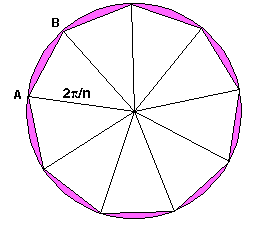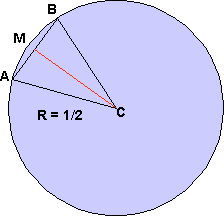By definition, the number
a0 + a1x + a2x2 + … + anxn = 0
where the ai are all rational numbers and n is finite. For comparison,  is also an irrational number. But
is also an irrational number. But  is not
is not
transcendental since it is a root of the equation
x2 - 2 = 0
Both  and
and  are irrational, but only
are irrational, but only  is transcendental. What makes the difference? One important argument is that a line of length
is transcendental. What makes the difference? One important argument is that a line of length  can beconstructed using classical techniques (i.e., using compass and straight-edge in a finite number of steps). But, because of the way
can beconstructed using classical techniques (i.e., using compass and straight-edge in a finite number of steps). But, because of the way  is defined, a line of length
is defined, a line of length  cannot be so constructed. (A curve can. Mark off a unit segment. Bisect the segment. Using the midpoint as center, scribe the appropriate circle. The circle has length
cannot be so constructed. (A curve can. Mark off a unit segment. Bisect the segment. Using the midpoint as center, scribe the appropriate circle. The circle has length  .)
.)
To illustrate, let us first consider  . To make a construction that produces a line of this length, we begin with two unit-length segments placed end to end so that one segment is at right angles with the other. We then, connect the free ends to complete a right triangle. The new line has length
. To make a construction that produces a line of this length, we begin with two unit-length segments placed end to end so that one segment is at right angles with the other. We then, connect the free ends to complete a right triangle. The new line has length 
Now, consider  . A circle of unit diameter has its circumference =
. A circle of unit diameter has its circumference =  . Draw a unit circle, and locate its center. From the center produce a set of n radial lines each separated from its neighbor by an angle 2
. Draw a unit circle, and locate its center. From the center produce a set of n radial lines each separated from its neighbor by an angle 2 /n.
/n.

Approximation for n = 9


Isoseles Triangle
Now, connect the ends with straight line segments to form a set of isosceles triangles. The sum of the lengths of these straight-line segments approaches the circumference of the circle as n approaches infinity (see figure for n = 9).
To construct a line of length  , we have but to produce the length AB n times along any line. In the figure, n = 9, AB is a typical straight line segment completing an isosceles triangle, and Circumference
, we have but to produce the length AB n times along any line. In the figure, n = 9, AB is a typical straight line segment completing an isosceles triangle, and Circumference  9(AB) (see figure).
9(AB) (see figure).
Now, let us use some algebra to calculate the length AB in the general case. We begin by redrawing part of our previous picture.
One isosceles triangle ( ABC with one vertex at the center C and two more vertices on the circle at A and B) is selected (see figure). The angle subtended at C is 2
ABC with one vertex at the center C and two more vertices on the circle at A and B) is selected (see figure). The angle subtended at C is 2 /n. We wish to calculate the length AB, and then to estimate how good an approximation the value n(AB) is to the actual circumference of the circle.
/n. We wish to calculate the length AB, and then to estimate how good an approximation the value n(AB) is to the actual circumference of the circle.
The line CM bisects the angle 2 /n, and meets the line AB at right angles. Thus, the triangle CMA is a right triangle, and the length AM = ½(AB).
/n, and meets the line AB at right angles. Thus, the triangle CMA is a right triangle, and the length AM = ½(AB).
AM/(Radius) = AM/(½) = sin ( /n)
/n)
& AB = sin ( /n).
/n).
Finally, n(AB) = n sin ( /n).
/n).
Since the actual circumference of the circle is  , we now write
, we now write
n(AB) = { n sin (
n sin ( /n)}/
/n)}/
=  {(sin (
{(sin ( /n))/(
/n))/( /n)}
/n)}
=  {(sin (
{(sin ( ))/(
))/( )}
)}
where  =
=  /n.
/n.
The value n(AB) differs from  by the multiplicative factor (sin (
by the multiplicative factor (sin ( ))/(
))/( ), with
), with  =
=  /n.
/n.
Notice that, in the limit as n 
 ,
, 
 0 and (sin (
0 and (sin ( ))/(
))/( )
)  1. The value n(AB) does indeed approach
1. The value n(AB) does indeed approach  in the limit.
in the limit.
But, while the limitexists, the actual function f( ) = (sin (
) = (sin ( ))/(
))/( ) does not exist at
) does not exist at  = 0. It becomes the indeterminate form 0/0.
= 0. It becomes the indeterminate form 0/0.
Thus, although n(AB) may approach the actual circumference to any arbitrary precision we might desire, the actual value n(AB) =  can never be obtained from any construction of the type outlined above.
can never be obtained from any construction of the type outlined above.
---------
---------
http://www.grc.nasa.gov/WWW/k-12/Numbers/Math/Mathematical_Thinking/transcendentality_of_p.htm
